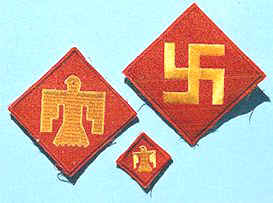There has been articles and comments regarding the use of the swastika on NT.
I would like to give you some background on the use of the swastika in the Native American culture. It has been used for centuries by the Native people. It is especially prominent among the Navajo Nation.
When it was co-opted by the Nazi's, the Native tribes stopped using it, even though they had used it for centuries. Today, you can find building in New Mexico with the swastika on them. These buildings would have been built before 1930.
Some of the finest woven rugs from the Navajo will have the swastika in them. These would be before 1940 or so.
To Indian tribes it is a symbol of good luck and represents the four directions/colors of mankind. It is also known as the ''whirling logs'' among other names.
Which brings me to the title of the article. The 45th Infantry Division insignia/patch was the swastika. This was changed to the Thunderbird with the rise of the Nazi's. The 45th Infantry was made up of National Guard units from Oklahoma, Colorado, Arizona and New Mexico. A substantial number of members were American Indians. Two of which were awarded the Medal of Honor. Van Barfoot and Ernest Childers.
The Thunderbird is used by many southwest tribes, and is the insignia for the Ojibwe Nation.
From the Swastika to the Thunderbird, the 45th Infantry Division. United States Army
 |
 |
For the first 15 years of its existence, members of the 45th Infantry Division proudly wore on their left shoulders an ancient American Indian symbol of good luck, most commonly referred to as the swastika. The insignia served as recognition of the great number of Native Americans proudly serving in the 45th Infantry Division. The yellow swastika on a square background of red symbolized the Spanish Heritage of the 4 Southwestern states that made up the membership of the 45th—Oklahoma, New Mexico, Colorado, and Arizona. A similar symbol was adopted by the Nazi party in the late 1920’s, and as the N.S.D.A.P. rose to power in 1933 the symbol became so closely associated with German National socialism that it had to be abandoned as the insignia of the 45th Infantry Division.
For many months division members wore no insignia, while the design for a new emblem was being explored. The 45th Infantry Division held a contest to assist in selection of the new insignia and many designs were submitted. The contest was overseen by a board of officers who eventually determined the Thunderbird would become the new insignia of the 45th Infantry Division. In keeping with the tradition formerly established, it was also decided to maintain the same colors and design of the original insignia.
In 1939 after approval of the Commanding General, Eighth Corps Area, and the Chief of the National Guard Bureau, the Thunderbird design was officially approved by the War Department and authorized for manufacture and wear. The document approving the design, which was to become famous in World War II and the Korean War, stated that, the Thunderbird was a Native American symbol signifying "sacred bearer of happiness unlimited." |
 |
|

|




A bit of history.
Very interesting, K. Thank you.
Your welcome Bob.
I have 4-5 bracelets, silver, with the symbol on them. They're from the 1880s. I love them and they are not so prominent that it would bother people who are sensitive. They were my great-grandmother's, and they are handmade with turquoise.
Grandma always said they were Indian symbols, and I never thought another thing about it.
They sound like very interesting pieces Dowser. Your lucky to have them.
Very lucky!
I love them and wear them a lot! And yes, people have commented on the swastikas, but I tell them what Grandma told me-- they are Indian symbols and they have nothing to do with swastikas. These bracelets, etc., were made in the 1880s-- LONG before the Nazis came along.
I knew that in sanskrit that they used a backwards swastika, but I never knew that indians used it until your article. Very interesting piece of history and it's a shame that the Nazi's have forever ruined the positive meaning of the symbol.
The first known sign that it was used by Indians, goes back to around 800 AD, with the Mississippian culture.
It's been around awhile with Indians.
I'm always enthralled to learn about our American Indian culture. If any culture could reclaim the heritage and honor of a symbol it would be the American Indian. Thank you for sharing.
Happy that you enjoyed the article Pj.
Great article Kavika! Although I knew the swastika design was used in the Navajo culture I wasn't aware the 45th Infantry Division utilized it as well. I'm just a little bit smarter now
It's past time to reclaim the historical significance of this design as it relates to multiple cultures around the world; a symbol of life instead of hatred and death.
Yes it is time to reclaim it Lynne. I'm sure it will be a real battle to do though.
Here is an interesting ad from the early 1900's.
The swastika has been around for a long long time.
The Swastika (also known as the gammadion cross , cross cramponnée , or wanzi ) (as a character: 卐 or 卍) is an ancient religious symbol that generally takes the form of an equilateral cross , with its four legs bent at 90 degrees. [1] [2] It is considered to be a sacred and auspicious symbol in Hinduism , Buddhism and Jainism and dates back to before 2nd century B.C. [3]
It has been used as a decorative element in various cultures since at least the Neolithic . It is known most widely as an important symbol long used in Indian religions , denoting "auspiciousness."
It was adopted as such in pre-World War I-Europe and later, and most notably, by the Nazi Party and Nazi Germany prior to World War II. In many Western countries, the swastika has been highly stigmatized because of its use in and association with Nazism. [4]
It continues to be commonly used as a religious symbol in Hinduism and Buddhism. [3]
Western literature's older term for the symbol, gammadion cross , derives mainly from its appearance, which is identical to four Greek gamma letters affixed to each other. [5] The name swastika comes from the Sanskrit word svastika ( Devanāgarī : स्वस्तिक), meaning "lucky or auspicious object". [5]
I would post a picture of the swastikas on my bracelets, but, I can't get into the computer that has the pictures... I've got to take that one in to be fixed. Sorry!
I, too, have learned something new from this article and the comments, Kavika, so thank you for posting it. I think it would be insensitive to renew its use, especially at this time when there are still Holocaust survivors among the living.
Indians are divided on renewing the use of it. The Navajo rug weavers have used it for centuries, and a few are starting to use it again.
Cultural and traditional differences - kinda like apples and oranges.